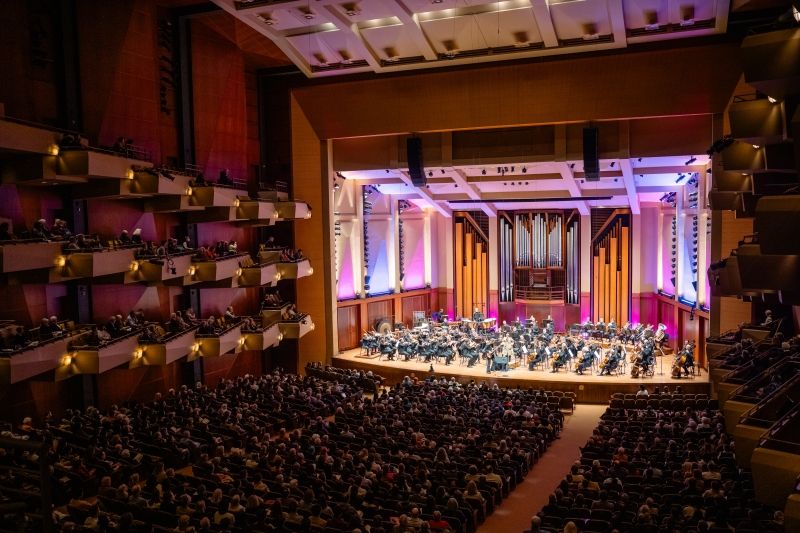Review: SIBELIUS SYMPHONY NO. 5 at Benaroya Hall
Scandinavian Passion Streams in Seattle

Two contemporary compositions provided the framework for the haunting, ebullient Symphony No. 5 in E-flat major, Op. 82 by iconic Finnish composer Jean Sibelius in a recent program, performed live in Benaroya Hall on Nov. 16, 2023, and streamed on the innovative Seattle Symphony+ service. Helmed by Finnish conductor Dalia Stasevska, who debuted with the orchestra in 2022, the program was intriguing and captivating.
Stasevska, who holds the positions of Chief Conductor of the Lahti Symphony Orchestra, Artistic Director to the International Sibelius Festival, and Principal Guest Conductor of BBC Symphony Orchestra, showed her talent and expertise in a wide scope of works that were traditional, starkly contemporary, and beguilingly original.
 The program opened with Nautilus from Scottish composer and sound artist Anna Meredith, which originally was composed as an electronic work and debuted with Stasevska and the Lahti Symphony Orchestra. Meredith, known as one of Britain’s most groundbreaking composers, is equally comfortable in multiple worlds—contemporary classical, art pop, soundtracks, techno and experimental rock. She has used such unusual techniques as clapping and stomping to substitute for instruments. Nautilus, a high-energy, continuous stream of movement, appeared on Meredith’s debut album, Varmints. The composer, who claims to have created the orchestral atmosphere while tramping on a Scottish beach, uses varied rhythms that mirrored her steps.
The program opened with Nautilus from Scottish composer and sound artist Anna Meredith, which originally was composed as an electronic work and debuted with Stasevska and the Lahti Symphony Orchestra. Meredith, known as one of Britain’s most groundbreaking composers, is equally comfortable in multiple worlds—contemporary classical, art pop, soundtracks, techno and experimental rock. She has used such unusual techniques as clapping and stomping to substitute for instruments. Nautilus, a high-energy, continuous stream of movement, appeared on Meredith’s debut album, Varmints. The composer, who claims to have created the orchestral atmosphere while tramping on a Scottish beach, uses varied rhythms that mirrored her steps.
The conductor started the piece with an appropriately aggressive energy, which is needed given the work’s repetitive nature: mostly rhythm, little or no melody. The extensive use of the brass served as a good warmup for the Sibelius to come in the second half of the program, and also an effective workout for the percussion section. One wonders if the piece would be more appealing in the electronic version.
In an intriguing twist, Stasevska shared the stage with her husband Lauri Porra, whose Entropia Concerto for Electric Bass was the second piece on the program. Porra, a great-grandson of Sibelius, is well-known in his native Finland as bassist for the popular power metal band Stratovarius and his own jazz/rock band, the Flyover Ensemble. He prefaced his performance with an engaging introductory speech about the importance of the orchestra as “the greatest instrument,” the little-known fact that the electric bass was invented in Seattle, and the use of entropy in the context of the chaos in combining the “brutal” nature of the electric bass with the beauty of the orchestra.

Entropia combines mysterious elements with a journey from tranquility to frenzied sounds and back to calmness. The electric bass provides melody and rhythm that is ever propelling forward. The combination of symphony with a bass guitar is an arresting one for the audience. Porra manages to meld the contrast between the two by connecting their two different worlds; thus the entropic allegory emerges by the meeting of musical minds that symbolically represent change in its limitless variations.
With the use of many special effects characteristic of the guitar itself, and many cadenza-type passages, the effect was at times meditative, at times chaotic, at times rock-jazzy. The orchestra writing seemed aleatoric in parts, but Stasevska controlled her forces ably, made the most of the melodic passages, and provided the steady beats needed by the orchestra, leading to a lyrical ending. The audience was pleased with the result. Concertmaster Noah Geller made an impressive showing in the extensive concerto-like violin solo.
 The 1915 Helsinki world premiere of the Sibelius Symphony No. 5 celebrated the Finnish cultural hero’s 50th birthday, a national holiday in Finland, in the midst of World War I. In an unusual structural move, the composer linked together the first two movements.
The 1915 Helsinki world premiere of the Sibelius Symphony No. 5 celebrated the Finnish cultural hero’s 50th birthday, a national holiday in Finland, in the midst of World War I. In an unusual structural move, the composer linked together the first two movements.
One of the advantages of the streaming format is that the camera angles not only show closeups of the individual players, but those of the conductor as well. Stasevska demonstrated her affinity for her native music, not to mention a comprehensive knowledge of the score, with a clear understanding of the subtleties set forth in the opening. Her long-armed, broad strokes, rhythmic body gestures and heartfelt facial expressions drew both subtlety and splendor from the orchestra’s first-class wind and brass sections. Especially appealing were the profound brass chorales and agile dance-like expressions in the winds at the heart of the movement.
The conductor then made the most of the delicacy of the pastoral-themed second movement with a gentle touch and perfectly paced tempo, then later by emphasizing the juxtaposition of the threatening hints of storm activity embodied in the timpani and brass.
In his notebooks, Sibelius writes of the inspiration drawn from the flights of swans above his country home. The lively and energetic tempo that started the finale progressed deftly to its characteristic “swan hymn,” which came off powerfully under Stasevska’s direction and gave the excellent horn section its moment to shine. Stasevska then made the most of the striking expectedness of the final six chords, wrapping up the dynamic, triumphant climax with great command, power, and authority.

Photo credit: Brandon Patoc
Reader Reviews

Videos

